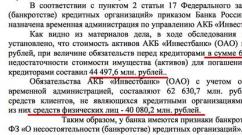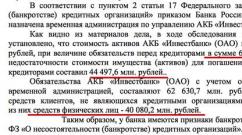Estimated reporting period code for 9 months. Tax period (code)
Anyone who has had to fill out standard reporting forms has already come across four-digit ciphers that stand apart from the names of rows in tables. These are accounting codes. They are needed, first of all, by tax authorities in order to automatically process huge amounts of data that come to them with documents. Special programs allow you to read them and analyze the information in a matter of seconds.
Digital codes are determined by the Order of the Ministry of Finance of the Russian Federation No. 66-n of 07/02/2010.
In this article, we will talk in more detail about the main codes used in standard forms of accounting reports.
Reporting line codes
They encrypt all information about the organization. They are put down directly in the reporting tables themselves. In Appendix No. 4 to Order No. 66-n, each code is linked to a separate report form.
Under the general accounting system, companies fill out 6 forms, and, accordingly, apply 6 types of codification:
Balance sheet. The line code has the form 1ХХХ;
- report on financial results: 2ХХХ;
- statement of changes in equity: 3ХХХ;
- cash flow statement: 4ХХХ;
- appendix to the balance sheet 5ХХХ;
- report on the intended use of funds 6XXX.
Inside each report there are sections, they are encrypted in the second line of code.
Example: section 2 of the balance sheet is called "current assets", and the lines in it begin with 12XX. Or the gross profit calculation section on Form No. 2: 21XX.
Subsections are encrypted in the third digit of the code.
Example: subsection "reserves" of the section "working capital" of the balance sheet - 121X.
The fourth, last digit of the code details the information in the subsection:
Example: the line "raw materials and materials" of the subsection "Stocks" has the code 1211.
As you can see, the structure has a clear construction logic, and is easy to use.
Companies using simplified accounting in their activities use the same coding.
Accounting period codes in 2018
The vast majority of legal entities submit financial statements once a year. For them, the reporting period code on the title page is always "34". But there are organizations that are required to report quarterly. For example, insurance companies. Codes for quarterly reports are provided:
- for the first quarter - "21";
- for the first half of the year - "31";
- for nine months - "33"
In the event of liquidation or reorganization of an enterprise, ciphers are provided:
- "94" - for interim reports;
- "90" - for the final report.
Codes of tax reporting periods in 2018
There are also two-digit codes in tax returns. Each period has its own codes, which have a two-digit register.
Income tax is considered a cumulative total and the codes will be as follows:
- 1 quarter - "21";
- 1st half - "31";
- 9 months - "33";
- year - "34". VAT is calculated quarterly, and the ciphers are different:
- 1 quarter - "21";
- 2 quarter - "22";
- 3 quarter - "23";
- 4 quarter - "24".
When submitting declarations in the process of reorganization or liquidation of an enterprise, code 50 is used. The first digit 5 in the code always means for the tax authorities that this is the last reporting of the company.
Period codes for USN
The reporting period is a year, which means that the code “34” is always indicated in the ordinary declaration.
In special cases, codes apply:
- "50" - liquidation or reorganization;
- "95" - the last period before switching to another mode;
- "96" - the last period for the termination of business activities.
Period codes for UTII
Reports are submitted once a quarter, so the codes will be as follows:
- 1 quarter - "21";
- 2 quarter - "22";
- 3 quarter - "23";
- 4 quarter - "24".
Other codes
In addition to those listed, the following codes are affixed in the declarations:
- place of submission of the declaration;
- forms of reorganization (liquidation);
- method of submitting the declaration (in paper, electronic form, etc.);
The list of codes that must be entered in the declarations can be found in the relevant Orders of the Ministry of Finance:
- No. ММВ-7-3/ [email protected] dated October 29, 2014 - for VAT;
- No. ММВ-7-3/ [email protected] dated October 19, 2016 - for income tax;
- No. ММВ-7-21/ [email protected] dated March 31, 2017 - for property tax;
- No. ММВ-7-3/ [email protected] dated February 26, 2016 - according to the simplified tax system;
- No. ММВ-7-3/ [email protected] dated 07/04/2014 - according to UTII;
- No. ММВ-7-11/ [email protected] dated December 24, 2014 - according to 3-personal income tax.
It is not at all necessary to delve into the codes in order to correctly fill out the reports. Become a user of the service and the system will do everything for you.
The database of the service contains all the most up-to-date information, so you can be sure that the documents will be drawn up in accordance with the latest legal requirements for your taxation system.
By registering with the service, you will be able to:
- Do your own bookkeeping. You will enter transactions, and the system itself will post them into accounts, calculate taxes and generate reports.
- Send declarations and other reports to recipients directly from your personal account. We make an electronic signature for our users free of charge.
- Make payments with the budget and contractors. The system is integrated with banks, which allows you to transfer money in one click.
- Maintain personnel records. The system automatically prepares a package of documents for hiring a new employee, as well as documents for vacation or dismissal.
- Generate primary documents and send them to contractors. Requisites of both parties in waybills, acts and invoices are substituted automatically.
- Send requests to the tax office and the FIU. The answers will come to your personal account.
- Receive extracts from the Unified State Register of Enterprises and Legal Entities, check the reliability of counterparties.
- Ask questions to experts and get answers within a day.
- Receive training materials and mailings about changes in legislation.
And get three days of free access.
What codes of the settlement and reporting period to put down the calculation of insurance premiums, which has been submitted to the IFTS since 2017? Where on the title page and in section 3 to put down the codes? A table of codes with decoding, as well as a sample of codes on the title page, are in this reference material.
New fee calculation
Since 2017, the calculation and payment of insurance premiums have been controlled by the Federal Tax Service (Ch. 34 of the Tax Code of the Russian Federation). In this regard, from 2017, the calculation of insurance premiums for mandatory pension (social, medical) insurance must be submitted to the tax inspectorates. At the same time, the form of calculation is completely new. The new form was approved by order of the Federal Tax Service of Russia dated 10.10.2016 No. ММВ-7-11/551. For the first time, reporting using the new form is required for the first quarter of 2017. Cm. " ".
Reporting and settlement periods according to the Tax Code of the Russian Federation
Since 2017, insurance premiums have been regulated by the provisions of the Tax Code of the Russian Federation. So, in particular, Article 423 of the Tax Code of the Russian Federation defines the concepts of the settlement and reporting periods for insurance premiums:
- billing period is a calendar year;
- the reporting period is the first quarter, six months, nine months of the calendar year.
Period codes on the title page of the calculation
The calculation of insurance premiums, the form of which has been filled out since 2017 for the purpose of sending reports to the Federal Tax Service Inspectorate, includes, among other things, the title page.
In the title page, policyholders (organizations or individual entrepreneurs) need to fill in all the fields, except for the section “To be completed by an employee of the tax authority”. On the title page there are fields “Settlement (reporting) period and “Calendar year”.
In the field "Settlement (reporting) period" you need to reflect the code of the period for which the calculation is presented. These codes are indicated in Appendix No. 3 to the Procedure for filling out a single calculation of insurance premiums. Here is a table of these codes with decoding:
| The code | Name |
|---|---|
| 21 | 1 quarter |
| 31 | half a year |
| 33 | nine month |
| 34 | year |
| 51 | 1 quarter in case of reorganization (liquidation) of the organization |
| 52 | half a year in case of reorganization (liquidation) of the organization |
| 53 | 9 months in case of reorganization (liquidation) of the organization |
| 90 | year in case of reorganization (liquidation) of the organization |
In the "calendar year" field, enter the year in which you submit the calculation of insurance premiums. Accordingly, if you submit a calculation, for example, for the 1st quarter of 2017, then filling out the title page and the codes of the calculation period on it may look like this:

Keep in mind that the period codes have changed since 2017. Before, when you passed RSV-1 calculations, other codes were used:
- 3 - for the I quarter;
- 6 - for half a year;
- 9 - for nine months;
- 0 - per year.
Codes in Section 3
Section 3 is personalized information for each individual. In this section, you also need to show the code of the settlement (reporting) period:
- 21 - for the I quarter;
- 31 - for half a year;
- 33 - for nine months;
- 34 - per year.
If the calculation is formed during the reorganization or liquidation of the organization, the codes will be as follows:
- 51 - for the I quarter;
- 52 - for half a year;
- 53 - for nine months;
- 90 - per year.
The value of field 020 of section 3 must correspond to the value of the field "Settlement (reporting period (code)" of the title page of the calculation.
Since 2017, new codes for the billing period have been established in the calculation of insurance premiums. Below we have given the new codes in the form of a convenient table and their decoding in 2017.
Settlement and reporting period in the calculation of insurance premiums in 2017
What is the settlement and reporting period for insurance premiums, is enshrined in Art. 423 of the Tax Code of the Russian Federation:
These are the periods of time for which the company must submit a report. As for the deadlines for reporting, payers need to submit a calculation of insurance premiums no later than the 30th day of the month following the settlement (reporting) period. Separate deadlines for submitting the calculation on paper and in electronic form are not provided.
In the calculation of insurance premiums in 2017, both periods are reflected in one line, only with different codes.
For each billing period, the accountant puts his own code in the reporting. How to designate the billing period in the calculation of insurance premiums in 2017, and what code to put, we told further.
Important: The following sections of the report must be submitted: title, section 1 with its subsections, annex 2, related to section 1 and section 3. The remaining sections are provided for employers who made payments and payments at different rates from the standard.
Codes of periods for calculating insurance premiums
The code for the calculation period for calculating insurance premiums is indicated on the title page and in section 3. The third section is responsible for personalized information, information about it is below.
Code of the settlement (reporting) period on the title page
On the title, you need to fill in all the fields, except for the section "To be completed by an employee of the tax authority." Also on this sheet there are fields "Settlement (reporting) period" and "Calendar year".
In the line "Settlement (reporting) period" you need to write the code of the settlement period for calculating insurance premiums for which data is provided. All codes according to the new form are presented in Appendix No. 3 to the Procedure for filling out a single calculation for insurance premiums. We have listed them in the table below.
Example
The accountant submits the calculation of contributions for the six months. This billing period corresponds to period 31.
In a quarter, the accountant will report for 9 months - select code 33.
Table. Period codes with decoding
Important: On the title page, there was no need to indicate the average payroll and payroll number of the organization, as was the case in RSV-1. There is also no place for printing, the report can be certified simply with a signature.
For clarity, below is an example of filling out a report and using the billing period code in calculating insurance premiums for 9 months.
Calculation (reporting) period code in Section 3
As for the third section, it reflects data for each person who is listed in the organization. This section of the calculation of insurance premiums must reflect the same reporting period code that was indicated on the title page of the report. For this, in the section, p.020 is responsible.
1. The settlement period for insurance premiums is a calendar year.
2. Reporting periods are the first quarter, six months, nine months of a calendar year, a calendar year.
3. If the organization was created after the beginning of the calendar year, the first settlement period for it is the period from the date of creation to the end of this calendar year.
4. If the organization was liquidated or reorganized before the end of the calendar year, the last settlement period for it is the period from the beginning of this calendar year until the day the liquidation or reorganization is completed.
5. If an organization created after the beginning of a calendar year is liquidated or reorganized before the end of this calendar year, the settlement period for it is the period from the date of creation to the day the liquidation or reorganization is completed.
6. The rules provided for in paragraphs 3 - of this article shall not apply to organizations from which one or more organizations are separated or joined.
7. The amount of insurance premiums payable by policyholders shall be reduced by the amount of expenses incurred by them for the payment of compulsory insurance coverage in accordance with the legislation of the Russian Federation.
8. The insured has the right to set off the excess of expenses for the payment of compulsory insurance coverage over the amount of accrued insurance premiums against future payments.
9. During the settlement (reporting) period following the results of each calendar month, policyholders calculate monthly mandatory payments on insurance premiums based on the amount of payments and other remunerations accrued from the beginning of the settlement period until the end of the corresponding calendar month, and insurance premium rates, as well as discounts (surcharges) to the insurance rate minus the amounts of monthly obligatory payments calculated from the beginning of the billing period to the previous calendar month inclusive.
10. The amount of insurance premiums to be transferred is determined in rubles and kopecks.
11. Separate subdivisions of policyholders - legal entities that have bank accounts (other credit institutions) opened for transactions and which accrue payments and other remuneration in favor of individuals (hereinafter - separate subdivisions), perform the obligations of the organization to pay insurance premiums (monthly mandatory payments) and the obligation to submit calculations for accrued and paid insurance premiums at the place of its location, unless otherwise provided by paragraph 14 of this article.
12. The amount of insurance premiums (monthly mandatory payments) payable at the location of a separate subdivision is determined based on the size of the base for calculating insurance premiums related to this separate subdivision.
13. The amount of insurance premiums payable at the location of the organization, which includes separate subdivisions, is determined as the difference between the total amount of insurance premiums payable by the organization as a whole and the total amount of insurance premiums payable at the location of its separate subdivisions.
14. If the organization has separate subdivisions located outside the territory of the Russian Federation, the payment of insurance premiums (monthly mandatory payments) and the submission of calculations for accrued and paid insurance premiums for these separate subdivisions are carried out by the organization at its location.
15. In case of termination of activity by the insured in connection with its liquidation before the end of the billing period, the insured is obliged to submit to the insurer an application for state registration in connection with the liquidation of a legal entity or an application for state registration of the termination of activity as an individual entrepreneur to the insurer before the day of submission to the registering authority on accrued and paid insurance premiums for the period from the beginning of the billing period to the day of submission of the specified calculation, inclusive. Said calculation may be submitted in the form of an electronic document in accordance with the requirements of Article 24 of this Federal Law. The difference between the amount of insurance premiums payable in accordance with the said calculation and the amounts of insurance premiums paid by the insured from the beginning of the settlement period shall be payable within 15 calendar days from the date such calculation is submitted or returned to the insured in accordance with this Federal Law.
16. In case of reorganization of the insured - a legal entity, payment of insurance premiums and submission of settlements on accrued and paid insurance premiums shall be carried out by its successor (successors), regardless of whether the facts and (or) circumstances of non-performance or improper fulfillment by the reorganized legal entity of obligations to pay insurance premiums. If there are several successors, the share of participation of each of them in the performance of the obligations of the reorganized legal entity for the payment of insurance premiums is determined in the manner prescribed by the civil legislation of the Russian Federation. If the separation balance sheet does not allow determining the share of the successor of the reorganized legal entity or excludes the possibility of fulfilling the obligations to pay insurance premiums in full by any successor and such reorganization was aimed at non-fulfillment of obligations to pay insurance premiums, by a court decision, the newly formed legal entities may jointly and severally perform obligation to pay insurance premiums of the reorganized entity.
On January 1, 2017, the tax authorities finally approved a new reporting form for insurance premiums. The document was put into effect by Order No. ММВ-7-11/ [email protected] dated October 10, 2016. It also contains a detailed procedure for filling out the calculation of insurance premiums and the electronic submission format. How to fill out a new RSV correctly? For what periods and in what terms to submit this form? Who is recognized as taxpayers and is obliged to submit a single calculation even in the absence of activity, and who is allowed not to report? About all the nuances - further, you can download the calculation form at the end of the article.
The current form for calculating insurance premiums in 2017 was developed from scratch and is intended for the formation by policyholders of data on deductions for mandatory pension, social (VNiM) and medical insurance. The appearance of a new report (KND 1151111) is due to the addition of Chapter 34 to the Tax Code, which regulates the calculation and payment of insurance premiums (IC). A significant reform of the legislative norms partially returns employers to the UST already applied in the 2000s.
After 8 years (UST was abolished in 2009), the control authorities considered it appropriate to transfer the administration of contributions to the tax service and approved the heads. 34 NK. It is defined here that:
- All individual entrepreneurs and legal entities that make payments to individuals on the basis of employment contracts and GPAs belong to payers of the SV; as well as private practitioners (stat. 419 of the Tax Code).
- Objects for taxation of NE are payments to individuals under GPA and TD, under copyright agreements, as well as for the alienation of various rights (clause 1 of article 420 of the Tax Code).
- For the billing period, a year (calendar) is taken, for reporting - a quarter, half a year, 9 months. (Stat. 423 of the Tax Code).
- Deductions of the NE, as well as payment, are made by the insurers independently at the end of each reporting period, the transfer of debt is carried out taking into account the amounts paid for previous reporting periods (clause 1, article 431 of the Tax Code).
- Payment of ST is carried out no later than the 15th day (clause 3 of article 431 of the Tax Code).
- Accounting for NE in rubles with kopecks is carried out by taxpayers for each individual separately (paragraphs 4, 5 of Article 431 of the Tax Code).
- A single calculation is filled in on an accrual basis and is submitted based on the results of the reporting (calculation) periods no later than the 30th day (clause 7 of Article 431 of the Tax Code).
- The ERSV filing authority is the IFTS at the address of the legal entity (the address of residence of the individual entrepreneur). As for the EP, the submission of the report (KND 1151111) is performed at the place of registration in the case of independent settlements of the unit with the personnel.
Calculation of insurance premiums - the composition of the form
A typical unified calculation of insurance premiums in 2017 includes a title page and many sections. Due to the fact that the form combined summary data for various types of insurance, the document is very voluminous and consists of 3 main sections. At the same time, it is not necessary to form all sheets in a row, but Sec. 2 and is intended only for the heads of peasant farms. For the rest of the sections, those pages for which there is information are also filled. In any case (even with “zero” activity), it is required to submit - the title page, sec. 1, subsection 1.1, 1.2 from Appendix 1 to Sect. 1, adj. 2 to sec. 1, sec. 3.
The new calculation of insurance premiums includes:
- Title page - here the insured enters his registration data (TIN, KPP, name, OKVED2, IFTS authority, contact details), and also provides information on the reorganization and the reporting period.
- Information about an individual - this sheet is intended to be filled in by those individuals who are not registered as individual entrepreneurs and have not indicated the TIN code.
- Sec. 1 - the most extensive section of the ERSV is intended for entering summary data on all types of RV. Filling in is carried out for each type of contributions with the codes KBK, OKTMO, cumulative amounts for the entire billing period and the last 3 months as well.
- App. 1 to sec. 1 - here CBs are indicated in terms of OPS and OMS. At the same time, subsection 1.1, 1.2 are formed without fail by all insurers, and subsection. 1.3, 1.3.1, 1.3.2, 1.4 - only if the employer made certain types of payments.
- App. 2 to sec. 1 - here are the CBs in the part of VNiM. At the same time, the employer explains what types of benefits were issued to employees, how - directly or through the FSS (with the participation of the region in the pilot project), the number of insured individuals and the amount of the insurance base, contributions, as well as funds reimbursed from Social Insurance.
- App. 3 to sec. 1 - here the expenses for VNiM and in accordance with the legislation of the Russian Federation are indicated in total amounts and by types of cases. For reference, those benefits are indicated that have already been accrued, but have not yet been issued to individuals.
- App. 4 to sec. 1 - here are payments to various categories of individuals made at the expense of federal funds. For example, these are payments to Chernobyl victims who suffered at the Mayak plant, at the Semipalatinsk test site and in other radioactive territories.
- App. 5 to sec. 1 - this sheet is formed only by IT organizations in terms of the validity of the application of reduced tariff rates for IC (subclause 3, clause 1, article 427 of the Tax Code).
- App. 6 to sec. 1 - this sheet is formed only by firms on the simplified tax system engaged in construction, manufacturing and various services in terms of using the validity of reduced rates (subclause 5 clause 1 article 427 of the Tax Code).
- App. 7 to sec. 1 - for similar purposes, this sheet is formed only by simplified NPOs engaged in educational, scientific, social and other fields (subclause 7 clause 1 article 427 of the Tax Code).
- App. 8 to sec. 1 - the sheet is formed only by IP on the PSN (subclause 9, clause 1, article 427 of the Tax Code) to justify the use of reduced rates for SV.
- App. 9 to sec. 1 - the sheet is formed for payments to foreign individuals and temporarily staying in Russia.
- App. 10 to sec. 1 - the sheet is filled in for payments to full-time students for work in special student teams (subclause 1 clause 3 article 422 of the Tax Code).
- Sec. 2 - this section of the new ERSV is intended for the formation of information on the SV by the heads of the peasant farm.
- App. 1 to sec. 2 - here the payment amounts are calculated.
- Sec. 3 - here personal information is provided for all insured individuals. At the same time, subsection 3.2.1 is obligatory for formation by all taxpayers, and 3.2.2 - only by paying fees for additional tariffs in terms of individual payments.
Note! The calculation of insurance premiums (KND 1151111) does not indicate the amounts for "injuries" that remained under the jurisdiction of Social Insurance: reporting 4-FSS (on a new form) and payment of fees is made to the territorial division of the FSS.
How to fill out the calculation of insurance premiums in 2017
Filling in a single form for calculating insurance premiums is carried out in accordance with the requirements of Order No. ММВ-7-11 / [email protected] dated 10.10.16, the Regulations must be observed by all insurers, regardless of the legal form and scope of activity. The instruction for filling contains the rules for entering data into the title page, sections, subsections and applications. Separate codes are given:
- According to the options for submitting a report (Appendix 1 to the Procedure) - 01 - for a paper document sent via mail; 02 - for a personally submitted paper form, 04 - for a form submitted through an EDS; 09 (10) - when using barcodes.
- According to the forms of reorganization or liquidation of the company (Appendix 2) - from 1 - for transformation and 2 - for merger to 0 - for liquidation.
- By periods (Appendix 3) - the code of the billing period, that is, years - 34, quarter code - 21, half-years - 31.9 months. – 33. A special coding has been developed for insurers who have undergone reorganization or liquidation.
- By tariffs (Appendix 5) - the payer's tariff code differs according to the applied taxation system and types of activity. For example, for a company on the OSNO and the general tariff SV - 01, for a company on the simplified tax system and the general tariff SV - 02, for the exchangers - 03, etc.
- By place of submission of the form (Appendix 4) - the coding differs depending on who exactly submits the report. For example, if a Russian enterprise reports - 214, its successor - 217, OP of a Russian organization - 222, IP - 120, etc.
- By types of certifying documents (Appendix 6) - the coding has been developed for the main types of certifying documents. For the passport of a Russian citizen - 21, military ID - 07, birth certificate of an individual - 03, passport of a foreigner - 10, etc.
- For the subjects of the Russian Federation (Appendix 7) - each subject (other settlements) of the Russian Federation has its own coding. Moscow - 77, Moscow region. - 50, Rostov region. - 61, Omsk region. - 55, etc.
- By categories of insured individuals (Appendix 8) - this category code is given on p. 200 subsection. 3.2.1. For example, for ordinary employees, you need to indicate HP.
Algorithm for filling out the calculation of insurance premiums in 2017
It is not enough to know how to fill out a new calculation, you also need to remember the ratios of indicators both within the ERSV and in comparison with reporting to the FSS for injuries and to the IFTS for payments to individuals (6-NDFL). When calculating the total amounts of ST for the GPT in sec. 1 line 030 should reflect data for the entire period, and lines 031-033 - for the last three months; line 040 and line 020 are reserved for filling in the corresponding BCC. Line 070 of the calculation is formed only by policyholders on the additional tariff for the OPS, and line 090 is formed by employers paying SV for additional provision.
Rules for compiling the form of calculation for SV:
- The title page is filled in first - the data is taken from the registration tax certificates, the field reserved for the number of pages is left blank for now.
- Next, section 3 of the calculation of insurance premiums is filled in - here it is necessary to include personalized information on all insured persons registered in the reporting period. These are also those who, for various reasons, do not receive remuneration, but remain on the employer's staff. For example, maternity leave; child caregivers, employees on unpaid leave, etc.
- Then fill in subsection. 1.1 and 1.2 to sec. 1 - that is, contributions to OPS and OMS. Remember that the data must match those entered in sec. 3.
- To reflect contributions for VNiM, Appendix 2 to Sec. 1 - accruals are indicated here, as well as the insurance costs incurred and the amounts reimbursed by Social Insurance. If there were benefits in the period, Appendix 3 and page 070 of the appendix are additionally filled out. 2. If not, adj. 3 is not required.
- At the very end, the summary amounts are posted in the section. 1 - here are the OKTMO code, CCC contributions and accruals for the entire period, including for the last 3 months.
- In conclusion, the completed pages are numbered using the chronological method, the resulting number is affixed to the title page, the head of the insured certifies the EPCB with a personal signature and seal.
An example of filling out the calculation for insurance premiums 2017
The following is an example of compiling ERSV for 9 months. 2017. The format of sending depends on the number of staff of the insured. Employers with more than 25 employees are required to report only in electronic form (clause 10 of article 431 of the Tax Code), others can also submit a calculation “on paper”. If the delivery obligation is performed by the representative of the insured, a notarized power of attorney will be required.
When sending a report, it is first necessary to check the specified information, since if there are errors or inaccuracies, the EPRS will not be accepted and a negative protocol will be received. At the same time, the payer may receive from the IFTS a requirement to provide explanations regarding the use of reduced tariffs or the reflection of non-taxable amounts. For example, error code 0400500003 means a mismatch in the calculation of personal information for individuals with the database of the tax service. Submission of incorrect TIN, SNILS or full name for employees entails a refusal to accept reports. In order for the calculation to be accepted, you should correct the information and send the document again.
If you find an error, please highlight a piece of text and click Ctrl+Enter.













